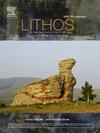南设得兰群岛Livingston岛早白垩世至始新世岩浆演化:来自侵入套的年代学和同位素地球化学约束
IF 2.5
2区 地球科学
Q2 GEOCHEMISTRY & GEOPHYSICS
引用次数: 0
摘要
暴露在利文斯顿岛的岩浆产物构成了南设得兰岩浆弧的一部分,该岩浆弧建立在活跃的大陆边缘上。利文斯顿岛的主要岩浆岩相包括早至晚白垩世深部岩体和火山岩组合、始新世深部岩体以及零星分布的古新世至始新世岩脉侵入岩。本文提供的40Ar39Ar和锆石UPb年代学资料定义了四个不同的侵入活动时期,分别为Hesperides (125 Ma)、Cerro Mirador (104-97 Ma)、Siddons Point (80 Ma)和Barnard Point套(42 Ma),此外还有一些侵位年龄为105 - 40 Ma的岩脉侵入。侵入岩以镁铁质至中间组分为代表,具有中钾、钙碱性亲和特征,只有始新世活动的少数样品具有拉斑岩特征。微量元素、Sr-Nd-Pb同位素和锆石Hf同位素变化表明,早白垩世至晚白垩世活动中,岩浆形成于俯冲背景,广泛涉及大陆地壳熔融体。地壳输入对熔体化学的影响随着时间的推移而减弱,特别是从古新世开始,导致岩浆产生具有典型的海洋岛弧地球化学特征。熔体化学的这种变化可能部分与回滚引起的覆盖板块伸展有关,这导致熔体运动速率的时间积分增加和在地壳水平上停留时间的减少。板块收敛速率的系统性降低导致板块变陡,导致同位素衰竭地幔组分的参与增强,形成具有可变俯冲特征的非均质烃源岩。本文章由计算机程序翻译,如有差异,请以英文原文为准。
Early Cretaceous to Eocene magmatic evolution of Livingston Island, South Shetland Archipelago: Geochronological and isotope geochemical constraints from intrusive suites
The magmatic products exposed across Livingston Island comprise a part of the South Shetland magmatic arc built on an active continental margin. The main magmatic phases of Livingston Island include the Early to Late Cretaceous plutonic and volcanic rock associations, the Eocene plutons, and some sporadically distributed intrusions of Paleocene to Eocene dykes. The intrusions were emplaced into the strongly deformed turbiditic sedimentary rocks of the Miers Bluff Formation. 40Ar![]() 39Ar and zircon U
39Ar and zircon U![]() Pb geochronologic data presented here define four distinct episodes of intrusive activity represented by the emplacement of the Hesperides (125 Ma), the Cerro Mirador (104–97 Ma), the Siddons Point (80 Ma) and the Barnard Point suites (42 Ma), in addition to some dyke intrusions with emplacement ages of 105 to 40 Ma. The intrusions are represented by mafic to intermediate compositions characterized by middle potassic, calc-alkaline affinities, with only a few samples from the Eocene activity exhibiting tholeiitic character. Trace element, Sr-Nd-Pb isotope and zircon Hf isotope variations indicate magma generation in a subduction setting with extensive involvement of continental crust-derived melts for the Early to Late Cretaceous activity. The effects of crustal input on melt chemistry appear to have diminished in time, especially from the Paleocene onwards, leading to magma generation with typical oceanic island arc geochemical signatures. This change in melt chemistry is likely partly related to the roll-back induced overriding plate extension which resulted in a time-integrated increase in the rate of melt movement and a decrease in the residence time in crustal levels. Slab steepening caused by the systematic decrease in plate convergence rate led to an enhanced involvement of isotopically depleted mantle component, producing a heterogeneous source with variable subduction signature.
Pb geochronologic data presented here define four distinct episodes of intrusive activity represented by the emplacement of the Hesperides (125 Ma), the Cerro Mirador (104–97 Ma), the Siddons Point (80 Ma) and the Barnard Point suites (42 Ma), in addition to some dyke intrusions with emplacement ages of 105 to 40 Ma. The intrusions are represented by mafic to intermediate compositions characterized by middle potassic, calc-alkaline affinities, with only a few samples from the Eocene activity exhibiting tholeiitic character. Trace element, Sr-Nd-Pb isotope and zircon Hf isotope variations indicate magma generation in a subduction setting with extensive involvement of continental crust-derived melts for the Early to Late Cretaceous activity. The effects of crustal input on melt chemistry appear to have diminished in time, especially from the Paleocene onwards, leading to magma generation with typical oceanic island arc geochemical signatures. This change in melt chemistry is likely partly related to the roll-back induced overriding plate extension which resulted in a time-integrated increase in the rate of melt movement and a decrease in the residence time in crustal levels. Slab steepening caused by the systematic decrease in plate convergence rate led to an enhanced involvement of isotopically depleted mantle component, producing a heterogeneous source with variable subduction signature.
求助全文
通过发布文献求助,成功后即可免费获取论文全文。
去求助
来源期刊

Lithos
地学-地球化学与地球物理
CiteScore
6.80
自引率
11.40%
发文量
286
审稿时长
3.5 months
期刊介绍:
Lithos publishes original research papers on the petrology, geochemistry and petrogenesis of igneous and metamorphic rocks. Papers on mineralogy/mineral physics related to petrology and petrogenetic problems are also welcomed.
 求助内容:
求助内容: 应助结果提醒方式:
应助结果提醒方式:


